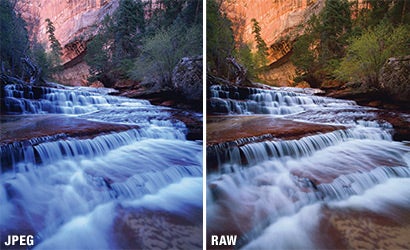Digital Toolbox: Why RAW Works
The visible difference between JPEG and RAW explained.

Sometimes there are good reasons to shoot JPEGs. You might be running out of space on your memory card, or you know you’ll never make prints of the pictures, or maybe you’re just a really, really, self-assured photographer.
But the JPEG format has limits. Since the file gets compressed the moment it’s taken, your camera’s settings are written in stone. Make the wrong call (or no call at all) on the white balance, for instance, and it will be a Sisyphean effort to fix the tone in Adobe Photoshop.
Want to rein in your contrast and saturation-happy JPEGs? You can either become adept at manipulating your camera’s image settings on the fly, or forget JPEGs and shoot RAW to take permanent charge of your shadows and highlights.
To show you the incredible difference between RAW and JPEG, we sent landscape photographer Marc Adamus into the field, and asked him to take the same picture in both formats. Check out the difference, and follow along as working in Adobe Camera RAW saves the day.